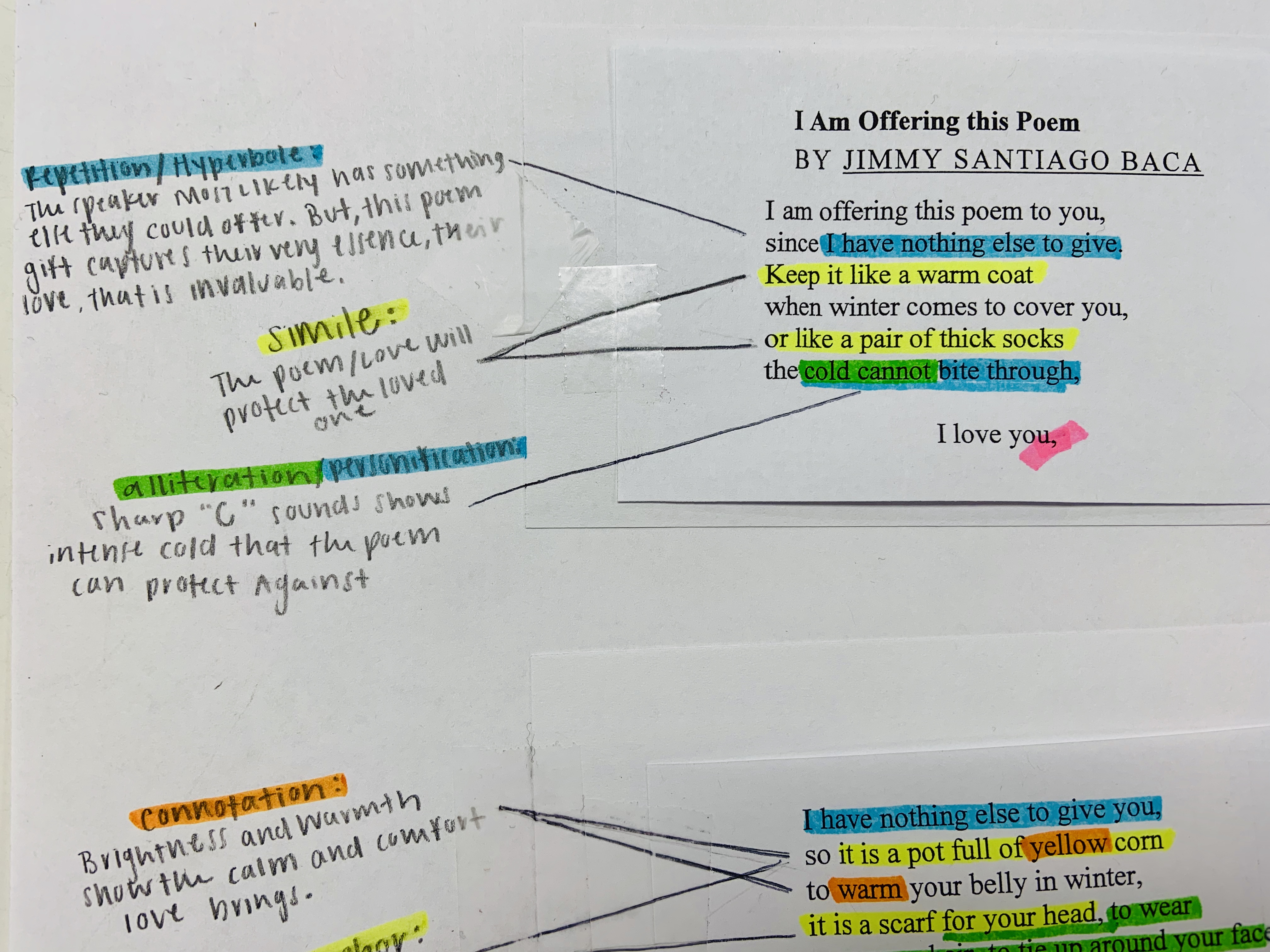
This lesson was posted originally in the AP Literature and Composition Facebook group by Amber Buckley, who gave her permission to share it here.
Materials needed:
- Jimmy Santiago Baca’s poem printed out and cut into individual stanzas. I taped the stanzas onto index cards myself (which took forever), so I suggest having students tape them to save time.
- Large paper (large enough to include all 4 index cards with room to write around)
- Tape
- Highlighters
Place the index cards in piles, along with the large paper for students to come pick up. Index cards should not be in order. Ask for a volunteer to choose a card and read it out loud for the class. Ask for another volunteer to read a second card, any card they chose. Repeat until all four cards are read out loud. Instruct students to place the cards in the order they believe is correct. The first one will be obvious since it includes the title of the poem. Personally, I like giving them one obvious choice by including the title of the poem on the first card to give them a boost of confidence to start. Once it looks like most students are finished, acknowledge that the first one was easy due to the title, then ask for someone to share what they guessed for the last card. Some students will notice that the final stanza is the only one that ends with a period (the rest end with a comma). Finally, ask for someone to share which card they put second and why. My classes are typically evenly split between the two options, and their reasons are varied. Once several students have shared, ask them if they would like to know the correct answer. Now that you’d built up their curiosity, of course they want to know and will attentively listen as you play a video of Jimmy Santiago Baca reading the poem.
Now that they know the correct order, have them arrange their cards appropriately in the middle of their larger sheet of paper, and tape down one side only of each index card. They will be writing on the back of their cards so they need to be able to flip it over. On the back of each card, they write two things: a literal paraphrase of the stanza, and their interpretation of what it means. What’s he really saying? What’s his message to his audience of “you”? Then, in the right side margins of the larger paper, students write their explanations for the order of the stanzas. How does it relate to the stanza that comes before it? Why does he separate each stanza with “I love you”? Finally, in the left side margins of the larger paper, students identify literary techniques, and explain how they are working in the poem. For example, my student Nicole notices the alliteration on the letter C in the first stanza to emphasize the sharp, biting cold. Nicole also explains the effect of asyndeton in the second stanza, “The continuous listing of uses for love reminds the audience of its importance and never-ending presence. The love will always be there to comfort and compliment the loved one.”

I allow students to work in pairs to discuss thoughts, but each student makes their own. As students get to work, I walk around and ask each group, “Who do you think the audience of the poem is? Who is the “you”? Some common answers are a child, a loved one, or even the speaker himself.

Jordyn’s interpretation of the poem is that the speaker is addressing himself, reminding himself to see his worth, and love himself, so she chooses an image of a mirror to frame her work.

As mentioned in the lesson description, Nicole’s annotations notice alliteration of C, along with other techniques like simile, personification, repetition, and hyperbole.

Katie explains why the poet ends each stanza with “I love you,” and each stanza is related to the one before it.
Thank you for reading! Do you have a story, lesson, activity, or something else to share with TeachLivingPoets.com? Be a guest author! Email me at msmith@lncharter.org.
You can follow me on Twitter at @MelAlterSmith and please tweet all the awesome things you are doing in your class with the #TeachLivingPoets hashtag!


Love this idea! An alternative to pasting on index cards would be to print the poem on cardstock, with each stanza in a separate corner.
LikeLike